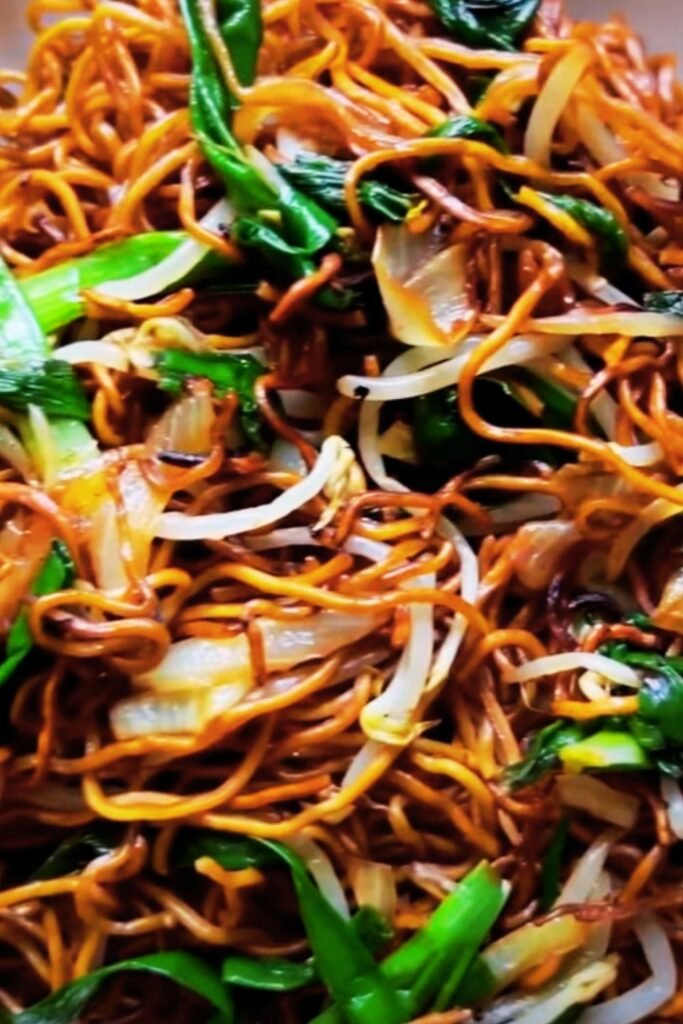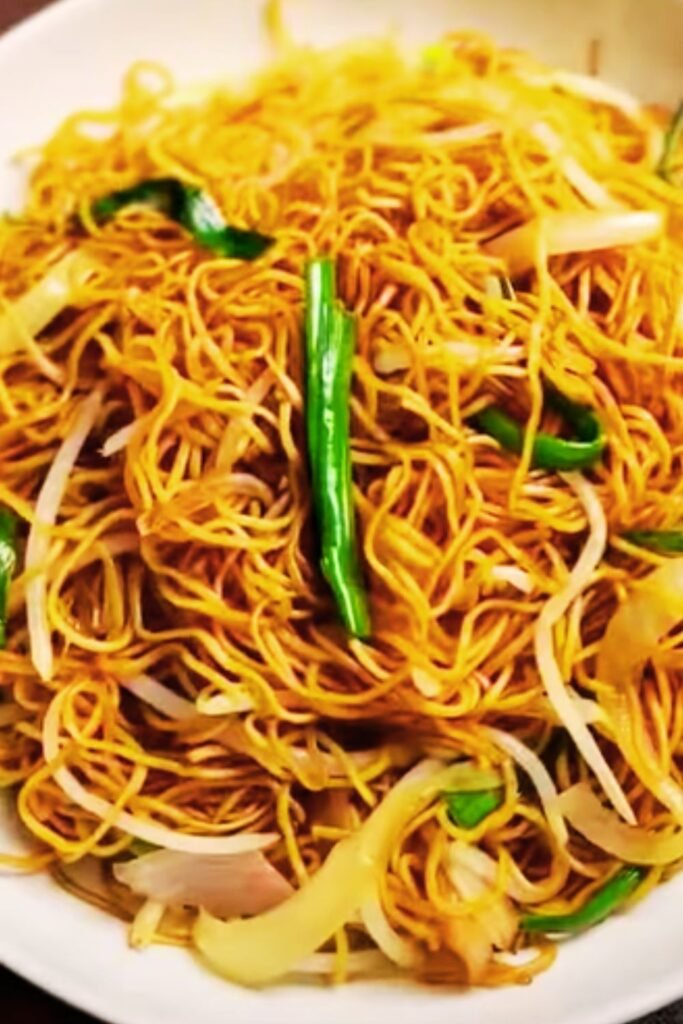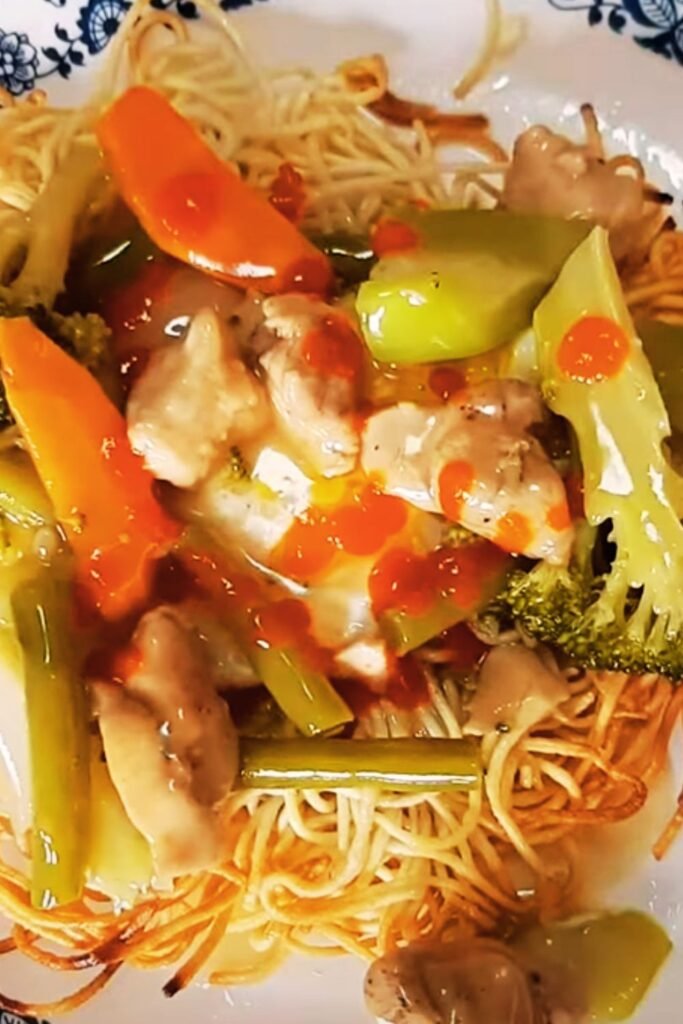There’s something magical about the transformation that happens when fresh egg noodles hit a hot wok. That sizzling sound, the aroma of toasting wheat, and the anticipation of those perfectly crispy-on-the-outside, tender-on-the-inside noodles. Today, I’m sharing one of my all-time favorite comfort dishes: Cantonese Pan-Fried Noodles with Soy Sauce, or as it’s traditionally known, “see yow wong chow mein.”
This dish holds a special place in my heart. Growing up, it was my go-to order at our local Cantonese restaurant. I’d watch in awe as the chef would flip those noodles with lightning speed, creating that perfect contrast between crispy edges and soft centers. Now, I make this dish regularly in my own kitchen, and I’m excited to show you how you can recreate this Cantonese classic at home.
What makes this dish truly special is its beautiful simplicity. With just a handful of ingredients and the right technique, you can create a restaurant-quality meal that’s impressive enough for guests yet simple enough for a weeknight dinner. The noodles develop a gorgeous golden crust while remaining tender inside, and the savory soy sauce mixture coats each strand perfectly, creating a harmony of textures and flavors.
What Are Cantonese Pan-Fried Noodles?
Cantonese pan-fried noodles (wong chow mein) are a staple in Cantonese cuisine. Unlike stir-fried noodles that are tossed throughout cooking, these noodles are allowed to form a crispy bottom layer while the top remains softer. The dish comes in two main varieties:
- See yow wong chow mein – Noodles fried with soy sauce (the recipe we’re making today)
- Sup chow mein – Noodles topped with a gravy-like sauce and various proteins and vegetables
What sets authentic Cantonese pan-fried noodles apart is the technique. The noodles aren’t just stir-fried; they’re allowed to form a crispy crust against the hot wok or pan before being gently flipped. This creates that characteristic texture contrast that makes this dish so beloved.
Essential Ingredients

The Noodles
- Fresh egg noodles: These thin, yellow noodles are the foundation of our dish. Their egg content helps them develop that perfect crispy texture when pan-fried. Look for Hong Kong-style pan-fry noodles or chow mein noodles in the refrigerated section of Asian markets.
Substitution: If you can’t find fresh egg noodles, dried egg noodles can work in a pinch. Cook them until just al dente (slightly undercooked), then drain well and proceed with the recipe. The texture won’t be identical, but you’ll still get a delicious result.
The Sauce
- Light soy sauce: Provides the primary salty flavor and beautiful amber color.
- Dark soy sauce: Adds depth, umami, and a richer color to the noodles.
- Oyster sauce: Contributes a complex sweetness and body to the sauce.
- Sesame oil: Just a touch brings aromatic nuttiness that elevates the entire dish.
- Sugar: A small amount balances the saltiness of the soy sauces.
- White pepper: Adds a subtle heat that’s characteristic of Cantonese cooking.
Aromatics & Vegetables
- Garlic: Minced fresh garlic is quickly stir-fried to infuse the oil with flavor.
- Scallions/Green onions: Divided into white and green parts, they’re used at different stages for both flavor and garnish.
- Yellow chives (optional): A traditional ingredient that adds a mild, sweet onion flavor.
- Bean sprouts: Provide a fresh crunch that contrasts beautifully with the noodles.
Protein Options (Optional)
While the classic version is often served plain or with minimal additions, you can add:
- Sliced chicken breast
- Shrimp
- Char siu (Chinese BBQ pork)
- Thinly sliced beef
- Tofu (for a vegetarian option)
Equipment You’ll Need
- Wok or large non-stick skillet: A 14-inch wok is ideal, but a 12-inch non-stick skillet works well too.
- Thin metal spatula: Perfect for getting under the noodles without breaking them.
- Small bowl: For mixing your sauce ingredients.
Step-by-Step Cooking Method
Preparation
- Prepare the noodles: If using fresh egg noodles, loosen them with your fingers to separate the strands. If they’re very tightly packed, rinse briefly with cold water to help separate them, then drain thoroughly and pat dry with paper towels. Any excess moisture will prevent proper crisping.
- Mix the sauce: In a small bowl, combine 2 tablespoons light soy sauce, 1 teaspoon dark soy sauce, 2 teaspoons oyster sauce, ½ teaspoon sesame oil, ¼ teaspoon sugar, and a pinch of white pepper. Stir until the sugar dissolves.
- Prepare the aromatics: Mince 2 cloves of garlic and slice 3-4 scallions, separating the white and green parts. If using yellow chives, cut them into 2-inch segments.
- Prepare bean sprouts: Rinse 2 cups of bean sprouts and drain well.
Cooking Process
- Heat your wok or pan: Place your wok over high heat until it’s smoking slightly. Add 3 tablespoons of neutral oil (such as vegetable or peanut oil) and swirl to coat the surface.
- Add the noodles: Spread the noodles in an even layer across the bottom of the wok. Press them down gently with your spatula to ensure good contact with the hot surface.
- Let them crisp: Allow the noodles to cook undisturbed for about 2-3 minutes until the bottom becomes golden and crispy. Resist the urge to stir!
- Flip the noodles: Using your spatula, carefully flip sections of the noodles. Don’t worry if they don’t flip perfectly – the charm of this dish is in its rustic appearance. If needed, add a little more oil around the edges of the wok.
- Crisp the other side: Let the noodles cook for another 2 minutes to crisp up on the other side.
- Add aromatics: Push the noodles to one side of the wok and add the minced garlic and white parts of scallions to the cleared area. Stir-fry for about 30 seconds until fragrant.
- Pour in the sauce: Drizzle the sauce mixture evenly over the noodles. Quickly toss everything together to coat the noodles evenly with sauce. The high heat will cause the sauce to caramelize slightly on the noodles, creating incredible flavor.
- Add bean sprouts: Toss in the bean sprouts and yellow chives (if using). Stir-fry for just 30-60 seconds – the bean sprouts should retain their crunch.
- Finish with scallion greens: Turn off the heat and sprinkle the green parts of the scallions over the top.
If Adding Protein
If you’re adding protein, cook it separately first:
- Heat 1 tablespoon oil in your wok.
- Add your protein of choice (about 8 oz, thinly sliced or diced).
- Stir-fry until just cooked through.
- Remove from the wok and set aside.
- Add the protein back to the wok after you’ve added the sauce to the noodles.
Tips for Perfect Pan-Fried Noodles

Getting That Perfect Crisp
- Dry noodles thoroughly: Moisture is the enemy of crispiness. If your noodles are wet, they’ll steam rather than fry.
- Hot wok, cold oil: Make sure your wok is properly heated before adding oil. This prevents sticking and promotes that perfect sear.
- Patience is key: Resist the urge to stir the noodles too soon. Let them develop that golden crust.
- Use enough oil: Don’t be shy with the oil – you need enough to create that crispy texture. You can drain the noodles on paper towels afterward if you’re concerned about excess oil.
Common Mistakes to Avoid
- Overcrowding the pan: If your wok or skillet is too small for the amount of noodles, cook them in batches. Overcrowding leads to steaming rather than frying.
- Using low heat: High heat is crucial for proper crisping. Make sure your wok or pan is hot enough before adding the noodles.
- Stirring too frequently: Let the noodles sit undisturbed to develop that crust.
- Too much sauce: While flavorful, too much sauce will make your noodles soggy. Use just enough to coat the noodles lightly.
Nutritional Information
| Nutrient | Amount (per serving) |
|---|---|
| Calories | 380 |
| Carbohydrates | 52g |
| Protein | 10g |
| Fat | 15g |
| Sodium | 890mg |
| Fiber | 3g |
| Sugar | 2g |
Note: Nutritional values are approximate and will vary based on specific ingredients and portions.
Serving Suggestions

Cantonese pan-fried noodles work beautifully as both a main dish or side. Here are some recommendations for serving:
As a Main Course
- Serve with stir-fried vegetables like bok choy, Chinese broccoli, or snap peas on the side.
- Add a fried egg on top for an extra protein boost and visual appeal.
- Include a small dish of chili oil or sambal for those who enjoy some heat.
As Part of a Larger Meal
- Pair with Cantonese steamed fish or a simple stir-fried protein.
- Serve alongside congee for a traditional Cantonese meal.
- Include some pickled vegetables for a tangy contrast.
Drink Pairings
- Jasmine tea complements the savory flavors beautifully.
- Cold chrysanthemum tea offers a refreshing contrast.
- Sparkling water with a slice of lemon helps cleanse the palate between bites.
Customizing Your Noodles
One of the joys of this dish is how adaptable it is. Here are some ways to make it your own:
Vegetable Additions
- Thinly sliced carrots (add them early in the cooking process)
- Snow peas or sugar snap peas (add with bean sprouts)
- Sliced mushrooms (shiitake or button mushrooms work well)
- Baby corn or water chestnuts for extra crunch
Sauce Variations
- Add a splash of Chinese rice wine for depth
- Include a bit of hoisin sauce for sweetness
- Mix in chili oil or paste for heat
- Add a touch of five-spice powder for complexity
Special Diet Adaptations
Vegetarian/Vegan
- Use vegetarian oyster sauce (made from mushrooms) or hoisin sauce
- Add tofu or tempeh for protein
- Increase the variety of vegetables for more texture and flavor
Gluten-Free
- Use rice noodles instead of wheat-based egg noodles
- Ensure your soy sauce and oyster sauce are gluten-free (tamari is a good substitute)
- Double-check all condiments for hidden gluten
Storage and Reheating
While Cantonese pan-fried noodles are best enjoyed fresh, leftovers can be stored and reheated:
Storage
- Cool completely before refrigerating
- Store in an airtight container for up to 2 days
- Note that the noodles will lose their crispiness in storage
Reheating
- Heat a wok or skillet with a tablespoon of oil until hot
- Add the leftover noodles and press them down
- Let them crisp up again for 2-3 minutes before flipping
- Add a sprinkle of water around the edges if they seem dry
Cultural Significance
Cantonese pan-fried noodles are more than just a delicious dish – they’re a symbol of Cantonese culinary expertise. The technique of creating that perfect crispy-yet-tender texture is considered a mark of a skilled chef.
In Cantonese cuisine, these noodles often make an appearance at family gatherings and celebrations, symbolizing longevity. They’re particularly popular during Lunar New Year festivities, when families come together to share meals that represent prosperity and good fortune.
The dish is also a testament to the Cantonese philosophy of letting ingredients shine through relatively simple preparations. By focusing on technique rather than complex flavors or numerous ingredients, these noodles exemplify the elegant simplicity that’s characteristic of Cantonese cooking.
Questions & Answers
Q: Can I make this dish ahead of time?
A: While the components can be prepared ahead (mixing the sauce, slicing vegetables), the actual cooking should be done just before serving. The magic of this dish is in the contrast between crispy and soft textures, which is best when fresh from the wok.
Q: My noodles stuck to the pan. What did I do wrong?
A: Several factors could cause sticking: The pan wasn’t hot enough before adding noodles, you didn’t use enough oil, or the noodles were too wet. Make sure your wok is properly heated, use sufficient oil, and dry your noodles thoroughly before cooking.
Q: Is there a way to make this dish with less oil?
A: While some oil is necessary for the crispy texture, you can reduce it slightly by using a good non-stick pan and making sure your noodles are very dry before cooking. You can also blot the finished noodles with paper towels to remove excess oil.
Q: What’s the difference between these noodles and lo mein?
A: The main difference is in the cooking technique. Lo mein noodles are simply tossed with sauce and other ingredients, while these pan-fried noodles (chow mein) are allowed to crisp up on the bottom. Lo mein has a uniformly soft texture, while chow mein has that characteristic crispy-soft contrast.
Q: My local Asian market doesn’t have fresh egg noodles. What’s the best substitute?
A: Dried egg noodles or even spaghetti can work in a pinch. Cook them until they’re almost done but still firm (al dente), then drain thoroughly and let them dry a bit before proceeding with the recipe. The texture won’t be identical, but you’ll still get delicious results.
Q: How spicy is this dish traditionally?
A: Traditional Cantonese pan-fried noodles with soy sauce aren’t spicy at all. The flavor profile focuses on umami, slight sweetness, and the nutty taste of toasted noodles. However, you can certainly add chili oil or fresh chilies if you prefer some heat.
Q: Can I use regular soy sauce if I don’t have both light and dark?
A: Yes, you can use regular soy sauce, though the flavor won’t have quite the same depth. If using only regular soy sauce, add a tiny bit more sugar (about ⅛ teaspoon) to balance the flavor, and consider adding a drop of molasses for color if you want to replicate the look of dishes made with dark soy sauce.
Q: Why are my noodles soggy instead of crispy?
A: Soggy noodles usually result from too much moisture (either in the noodles themselves or from too much sauce), too low heat, or overcrowding the pan. Make sure your noodles are dry, your heat is high, and you’re not trying to cook too many noodles at once.
Final Thoughts
Creating restaurant-quality Cantonese pan-fried noodles at home is all about understanding a few key principles: proper heat, the right amount of oil, patience during cooking, and balance in your sauce. Master these elements, and you’ll be rewarded with a dish that’s simultaneously simple and sophisticated – crispy golden noodles with a perfect savory flavor that’s sure to become a regular in your cooking repertoire.
What I love most about this dish is how it transforms humble ingredients into something truly special. It’s a beautiful reminder that sometimes, the most satisfying cooking comes not from exotic ingredients or complicated techniques, but from doing simple things really well.
I hope you enjoy making these noodles as much as I do. There’s something incredibly satisfying about hearing that sizzle as the noodles hit the hot wok and watching them transform into a golden, crispy delight. And when you take that first bite – the contrast of textures, the savory umami flavor – well, that’s what makes cooking such a joy.